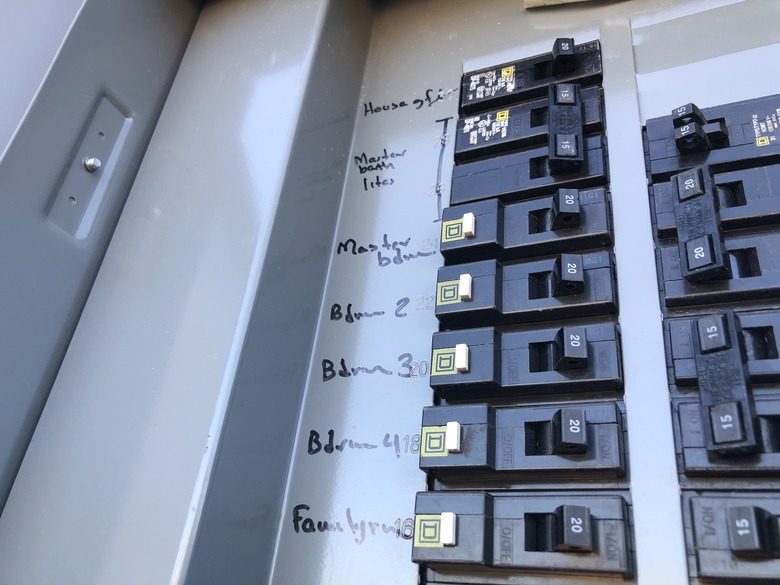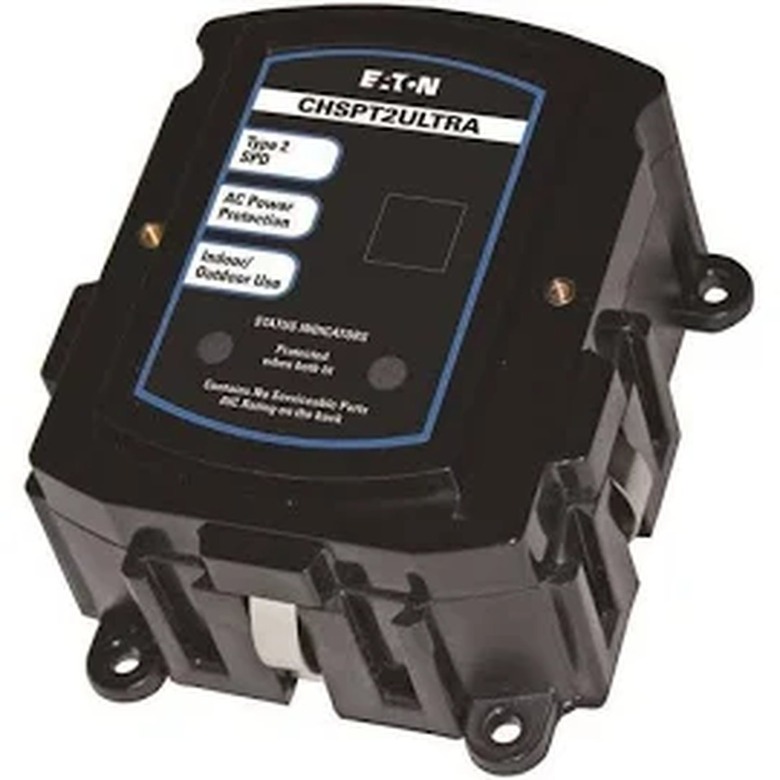Whole-House Surge Protectors: What They Are And Why You Might Need One
We may receive a commission on purchases made from links.
A whole-house surge protector is an electrical device designed to protect all the wiring in your home from power spikes that can damage sensitive microcircuits in electronic equipment in your home. Originally, surge protection was an issue only for computers, which were the only devices in the home that had such microcircuits. So when a major power surge occurred — such as lightning striking power lines — the circuit boards in a computer could be melted and fused, completely ruining the device.
But in a modern home, there are similar circuit boards in many different devices — now, even your toaster can be a smart device with delicate circuits that can be badly damaged if a major voltage surge occurs, and LED light bulbs have small circuit boards that can be ruined by power spikes. Today, a lightning strike even as far as a mile away can cause many thousands of dollars of damage to various devices and appliances with electronic components.
Fortunately, there are now many forms of surge protection available to prevent damage like this. You're likely familiar with a surge protection device that you plug in — sometimes referred to as type 3 surge protective devices (SPDs) — that serve to protect just a single outlet against relatively small electrical surges. But more comprehensive surge protection is offered by two types of whole-house SPDs, commonly known as type 1 and type 2. These whole-house surge protection devices protect all circuits in the home and everything plugged into them.
How Power Surges Occur
How Power Surges Occur
The power surges capable of damaging your electronic devices can originate from outside the home or from inside. The outer sources of power surges are often the most dramatic, such as when lightning strikes a nearby overhead power line, sending as much as 200,000 amps streaking into homes that have electrical services designed to handle only 100 or 200 amps. Other less dramatic but equally damaging outside surges can originate with malfunctions at the power utility.
Within the home, smaller power surges are even more common and are usually caused by large, motor-driven appliances cycling on and off. Even the start and stop cycle of a laser printer creates a very tiny power surge in the circuit powering it. While these surges do not instantly ruin sensitive electronics, they can create microscopic damage each time they happen. Over time, many small power surges can gradually ruin the circuitry of computers, televisions or even your microwave oven eventually. One day, an electronic device just stops working thanks to accumulated damage to its inner circuit boards.
Other sources of small in-home power surges include frequent tripping of circuit breakers or short circuits that occur repeatedly. Various types of in-home incidents account for 60 to 80 percent of all power surges, creating damage you may not even realize is occurring.
Multiple Layers of Surge Protection
Multiple Layers of Surge Protection
Maximum insurance against external and internal power surges is achieved by using multiple layers of protection offered by different SPDs. Most of these whole-home surge protection devices perform their suppression by sensing excessive power spikes and either restricting the flow of electrical current or redirecting that voltage to ground before it can course through the microscopic circuitry of the electronic equipment.
At the device level, most computers and other home electronics now integrate metal oxide varistors (MOVs) to help shunt power surges. The term "varistor" means "variable resistor," and these devices work by increasing their resistance when voltage exceeds an expected load. While MOVs can offer some protection from minor in-house surges, they are incapable of handling major power spikes. Computer and appliance power supplies are sometimes equipped with their own MOVs that offer some protection against these minor surges.
At the next level are plug-in surge protectors — usually a specialized type of power strip — that also include MOVs. It's wise to remember that not all power strips are surge protectors, and even those that do include surge-guarding MOVs do not offer anything resembling full protection against power spikes. These point-of-use surge protectors are often known as type 3 SPDs.
The final and most effective level of surge protection is offered by whole-house surge protectors, of which there are two types: type 1 and type 2. Both types are categorically different from MOV-type surge protectors. Rather than absorbing excess voltage, whole-house surge protectors serve to redirect the excess voltage to ground before it can flow through house circuits.
However, neither type of whole-house SPD is guaranteed to intercept and redirect all of the voltage generated during a major surge. In a lightning strike of a nearby power line, for example, it's estimated that roughly 15 percent of the excess voltage still makes it past the main surge protector. Therefore, it is very important that you utilize plug-in surge protectors in addition to one or more whole-house surge protectors.
Types of Whole-House Surge Protectors
Types of Whole-House Surge Protectors
Whole-house surge protectors can be installed so they intercept excess voltage spikes before they enter the home, or they can be installed inside the home to handle internal spikes. It's not uncommon for a house to employ both of these types; in fact, many experts recommend this approach.
- Type 1 whole-house surge protectors are installed near the home's electrical meter outside the home itself. This is a form of SPD that intercepts power spikes that originate outside the home (which account for about 20 percent of surges affecting homes) in the power grid itself and redirects the excessive voltage to ground before it even enters the house.
- Type 2 whole-house surge protectors are SPDs that are installed inside the home near the main circuit breaker panel, or main service panel. They are designed to sense power spikes originating inside the home (accounting for roughly 80 percent of the spikes that occur) and direct the excess voltage to ground. It's possible that your home will require multiple type 2 protectors if you have larger 200-amp or 300-amp service or if your home has one or more subpanels.
Code Requirements for Surge Protection
Code Requirements for Surge Protection
The value of whole-house surge protection has been known for some time, but it was not until the 2020 revision to the National Electrical Code (NEC) that whole-house protection was mandated for new residential construction or when new electrical services are installed in existing homes. This code revision requires either a type 1 or type 2 surge protector but not both. However, many professionals recommend installing both types for maximum protection as well as using type 3 plug-in surge protectors. The 2020 NEC does not require retrograde installation of a whole-house surge protector when routine repairs are made to an existing service.
Be aware, though, that not all states or municipalities use the most current NEC as the model for their own local electrical codes. It is possible that your state still uses the 2017 or even the 2014 NEC for its own guidelines, and these earlier code editions do not require whole-house surge protectors at all.
Installation of a Surge Protector
Installation of a Surge Protector
Although the installation of type 1 or type 2 whole-house surge protectors is not particularly difficult, it is virtually always done by a licensed electrician. A type 1 SPD requires that the main service from the utility be temporarily shut off as the electrician (or a utility technician) installs the device on the outside of the house just below the meter. The device has both hot and neutral terminal connections to which the main service wires will be attached before they continue on into the home's electrical panel. With a type 2 SPD, the electrician will shut off the service panel's main circuit breaker inside the panel and mount the surge protector inside or outside the panel before completing the connections.
Some type 2 surge protectors snap into the panel in much the same way as a double-pole circuit breaker. Once the surge protector is snapped into place, a white wire lead on the protector is connected to the neutral bus bar in the panel.
Other styles of type 2 protectors are separate devices that can be mounted either inside the panel or outside the panel in a small auxiliary box. With these, two hot wires are run to a separate dedicated double-pole breaker snapped onto the panel's hot buses. Neutral and ground wires are also run from the surge protector to the neutral/ground bus bar.
Again, surge protector installation is a job for a professional; it is not a DIY project.
Costs of Surge Protectors
Costs of Surge Protectors
The average cost of installing a good-quality whole-home surge protector, including the labor, can range from $300 to $600, and it is possible that your service will require more than one protector, such as if your house is equipped with a subpanel along with the main service panel. Still, this is fairly affordable insurance against the potentially huge cost of damage to your home electronics and appliances in the event of a major power surge.
Type 3 plug-in surge protectors typically cost $25 to $50. A special type of plug-in surge protector that offers uninterrupted power supply protection with battery backup ranges from $50 to $250. Remember that cheaper plug-in surge protectors cannot take the place of whole-house surge protectors. A well-protected home will have both types of devices.

